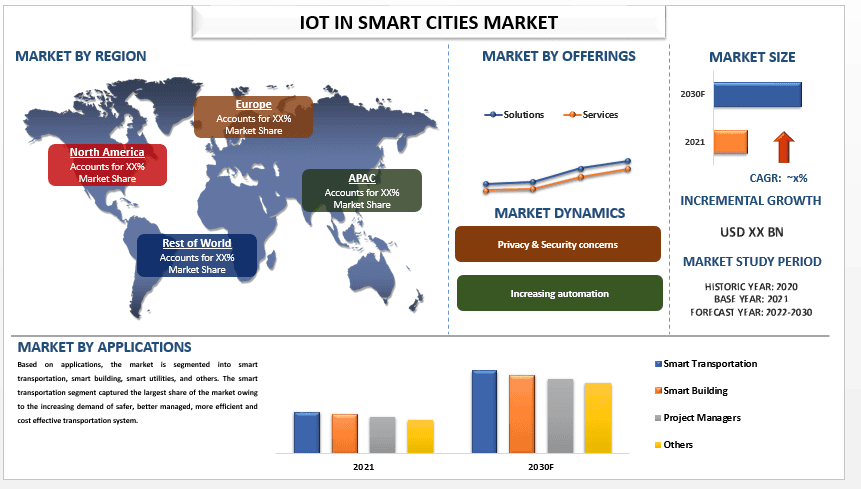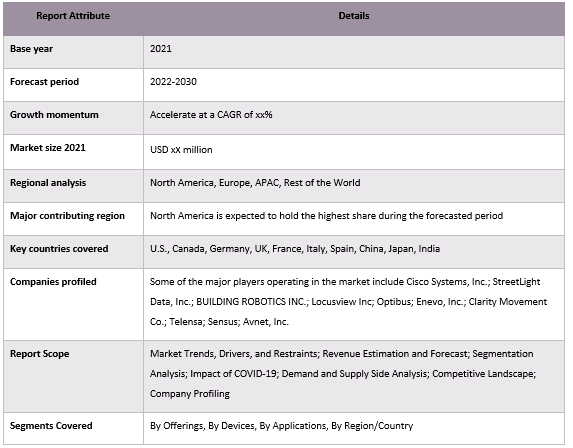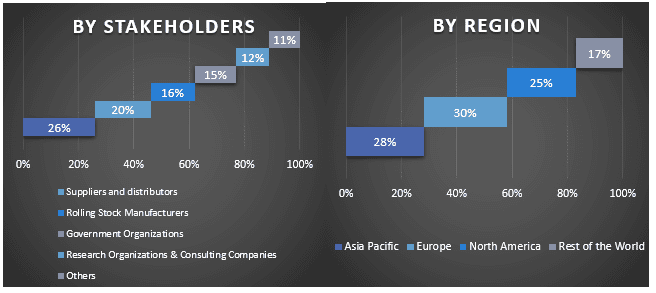- Accueil
- À propos de nous
- Industrie
- Services
- Lecture
- Contactez-nous
Marché de l'IdO dans les villes intelligentes : Analyse actuelle et prévisions (2022-2028)
Accent mis sur les offres (Solutions {Surveillance à distance, Système de localisation en temps réel, Gestion de données, Autres}, Services {Services professionnels, Services gérés}) ; Appareils (Capteurs intelligents, Caméras, Compteurs, Autres) ; Applications (Transport intelligent, Bâtiment intelligent, Services publics intelligents, Autres).

Le marché de l'IoT dans les villes intelligentes devrait croître à un TCAC important de xx % au cours de la période de prévision en raison de l'adoption croissante de technologies connectées et intelligentes dans les initiatives de villes intelligentes. Une ville intelligente est une ville qui utilise les technologies de l'information et de la communication (TIC) pour apporter le développement dans les villes, rendant la ville entièrement automatisée en augmentant l'efficacité opérationnelle. Les villes intelligentes comprennent le partage d'informations avec le public et l'amélioration à la fois de la qualité des services gouvernementaux et du bien-être des citoyens. L'objectif principal d'une ville intelligente est de maximiser les fonctions de la ville et d'encourager la croissance économique tout en améliorant la qualité de vie des citoyens grâce à l'utilisation de technologies intelligentes et d'analyse de données. En outre, la demande d'appareils IoT pour le développement de villes intelligentes est alimentée par la préférence croissante pour des solutions de gestion de l'énergie efficaces afin d'assurer un comptage approprié et de réduire le gaspillage des ressources. Les fournisseurs de technologies IoT sont également attirés par le développement d'infrastructures de transport dans les projets de villes intelligentes pour un meilleur contrôle et des installations de surveillance, une réduction des émissions de carbone et une optimisation et une planification compétentes des routes.
Certains des principaux acteurs opérant sur le marché comprennent Cisco Systems, Inc. ; StreetLight Data, Inc. ; BUILDING ROBOTICS INC. ; Locusview Inc ; Optibus ; Enevo, Inc. ; Clarity Movement Co. ; Telensa ; Sensus ; Avnet, Inc. Altus Group. ; Autodesk Inc. ; CoStar Group ; Microsoft ; MRI Software LLC ; Oracle ; RealPage, Inc. ; SAP SE ; Trimble Inc. ; Yardi Systems, Inc.
Aperçus présentés dans le rapport
« Parmi les offres, le segment des solutions détient la part la plus élevée du marché au cours de la période de prévision. »
Selon les offres, le marché est divisé en solutions et services. Selon les données, le segment des solutions représente la majorité des revenus. En raison de l'intégration de solutions Internet des objets (IoT) dans les technologies émergentes, les infrastructures sont plus sûres, la société est plus équitable, le taux de criminalité est réduit et des environnements technologiquement avancés sont mis à disposition. En raison de sa capacité à contrôler la force des aspects géospatiaux et à utiliser tous les ensembles d'informations, la disposition de révélation et d'examen est généralement utilisée.
Couverture du rapport sur le marché de l'IoT dans les villes intelligentes

« Parmi les appareils, le segment des capteurs a capturé la part majoritaire du marché de l'IoT dans les villes intelligentes en 2021. »
Selon les appareils, le marché est segmenté en capteurs intelligents, caméras, compteurs, autres. Parmi ceux-ci, le segment des capteurs intelligents conservera le TCAC maximal au cours de la période prévisionnelle afin de permettre la collecte automatisée de données environnementales avec une plus grande précision et une réduction du bruit erroné parmi les données enregistrées avec précision.
« L'Amérique du Nord détient la plus grande part du marché de l'IoT dans les villes intelligentes en 2021. »
L'Amérique du Nord détient la plus grande part des revenus. Le district est tenu d'utiliser des arrangements et des administrations basés sur l'IoT en raison de la disponibilité d'économies durables et profondément enracinées. De nouvelles technologies sont également développées à la suite de ces facteurs et des investissements croissants dans la recherche et le développement. En outre, les opérateurs de réseau de la région sont plus susceptibles d'investir dans le développement d'une infrastructure 5G, telle que l'informatique en périphérie du cloud et le découpage de réseau, ainsi que dans le renforcement et l'amélioration de leurs réseaux de télécommunications. De plus, l'adoption de l'IoT est croissante sur le marché des villes intelligentes pour une gestion urbaine économique et stratégique.
Raisons d'acheter ce rapport :
- L'étude comprend une analyse de la taille du marché et des prévisions validée par des experts clés authentifiés du secteur.
- Le rapport présente un aperçu rapide des performances globales de l'industrie en un coup d'œil.
- Le rapport couvre une analyse approfondie des principaux pairs du secteur en mettant l'accent sur les principales données financières de l'entreprise, les portefeuilles de produits, les stratégies d'expansion et les développements récents.
- Examen détaillé des moteurs, des contraintes, des tendances clés et des opportunités qui prévalent dans l'industrie.
- L'étude couvre de manière exhaustive le marché à travers différents segments.
- Analyse approfondie au niveau régional de l'industrie.
Options de personnalisation :
Le marché mondial de l'IoT dans les villes intelligentes peut être davantage personnalisé selon les besoins ou tout autre segment de marché. En outre, UMI comprend que vous pouvez avoir vos propres besoins commerciaux, n'hésitez donc pas à nous contacter pour obtenir un rapport qui correspond parfaitement à vos besoins.
Table des matières
Méthodologie de recherche pour l'analyse du marché de l'IoT dans les villes intelligentes (2022-2030)
L'analyse du marché historique, l'estimation du marché actuel et la prévision du marché futur de l'IoT mondial dans le marché des villes intelligentes ont été les trois principales étapes entreprises pour créer et analyser l'adoption de l'IoT dans les villes intelligentes dans les principales régions du monde. Une recherche secondaire exhaustive a été menée pour collecter les chiffres du marché historique et estimer la taille actuelle du marché. Deuxièmement, pour valider ces informations, de nombreuses conclusions et hypothèses ont été prises en considération. De plus, des entretiens primaires exhaustifs ont également été menés avec des experts de l'industrie à travers la chaîne de valeur du marché mondial de l'IoT dans les villes intelligentes. Après l'hypothèse et la validation des chiffres du marché par le biais d'entretiens primaires, nous avons utilisé une approche descendante/ascendante pour prévoir la taille complète du marché. Par la suite, des méthodes de ventilation du marché et de triangulation des données ont été adoptées pour estimer et analyser la taille du marché des segments et sous-segments de l'industrie concernée. La méthodologie détaillée est expliquée ci-dessous :
Analyse de la taille du marché historique
Étape 1 : Étude approfondie des sources secondaires :
Une étude secondaire détaillée a été menée pour obtenir la taille du marché historique de l'IoT dans le marché des villes intelligentes par le biais de sources internes à l'entreprise telles que les rapports annuels et états financiers, présentations des performances, communiqués de presse, etc., et des sources externes, y compris les revues, actualités et articles, publications gouvernementales, publications des concurrents, rapports sectoriels, base de données tierce et autres publications crédibles.
Étape 2 : Segmentation du marché :
Après avoir obtenu la taille du marché historique de l'IoT dans le marché des villes intelligentes, nous avons mené une analyse secondaire détaillée pour recueillir des informations sur le marché historique et les parts des différents segments et sous-segments pour les principales régions. Les principaux segments inclus dans le rapport sont les offres, les appareils et les applications. Des analyses plus approfondies au niveau des pays ont été menées pour évaluer l'adoption globale des modèles de test dans cette région.
Étape 3 : Analyse des facteurs :
Après avoir acquis la taille du marché historique des différents segments et sous-segments, nous avons mené une analyse des facteurs détaillée pour estimer la taille actuelle du marché de l'IoT dans le marché des villes intelligentes. De plus, nous avons effectué une analyse des facteurs à l'aide de variables dépendantes et indépendantes telles que le type, le mode de déploiement, l'utilisation finale et les applications de l'IoT dans le marché des villes intelligentes. Une analyse approfondie des scénarios de demande et d'offre a été menée en tenant compte des principaux partenariats, fusions et acquisitions, expansion commerciale et lancements de produits dans le secteur du marché de l'IoT dans les villes intelligentes à travers le monde.
Estimation et prévision de la taille actuelle du marché
Taille actuelle du marché : Sur la base d'informations exploitables tirées des 3 étapes ci-dessus, nous sommes parvenus à la taille actuelle du marché, aux principaux acteurs du marché mondial de l'IoT dans les villes intelligentes et aux parts de marché des segments. Tous les pourcentages de parts et les ventilations du marché requis ont été déterminés à l'aide de l'approche secondaire susmentionnée et ont été vérifiés par le biais d'entretiens primaires.
Estimation et prévision : Pour l'estimation et la prévision du marché, des pondérations ont été attribuées à différents facteurs, notamment les moteurs et les tendances, les contraintes et les opportunités disponibles pour les parties prenantes. Après avoir analysé ces facteurs, les techniques de prévision pertinentes, c'est-à-dire l'approche descendante/ascendante, ont été appliquées pour arriver à la prévision du marché pour 2028 pour différents segments et sous-segments sur les principaux marchés à l'échelle mondiale. La méthodologie de recherche adoptée pour estimer la taille du marché comprend :
- La taille du marché de l'industrie, en termes de revenus (USD) et le taux d'adoption de l'IoT dans le marché des villes intelligentes sur les principaux marchés nationaux
- Tous les pourcentages de parts, les divisions et les ventilations des segments et sous-segments du marché.
- Principaux acteurs du marché mondial de l'IoT dans les villes intelligentes en termes de produits proposés. De plus, les stratégies de croissance adoptées par ces acteurs pour concurrencer sur le marché en croissance rapide
Validation de la taille et de la part du marché
Recherche primaire : Des entretiens approfondis ont été menés avec les principaux leaders d'opinion (KOL), notamment les cadres de haut niveau (CXO/VP, chef des ventes, chef du marketing, chef des opérations, chef régional, chef de pays, etc.) dans les principales régions. Les résultats de la recherche primaire ont ensuite été résumés et une analyse statistique a été effectuée pour prouver l'hypothèse énoncée. Les contributions de la recherche primaire ont été consolidées avec les résultats secondaires, transformant ainsi l'information en informations exploitables.
Répartition des participants primaires dans différentes régions

Ingénierie du marché
La technique de triangulation des données a été utilisée pour compléter l'estimation globale du marché et pour parvenir à des chiffres statistiques précis pour chaque segment et sous-segment du marché mondial de l'IoT dans les villes intelligentes. Les données ont été divisées en plusieurs segments et sous-segments après avoir étudié divers paramètres et tendances dans les domaines du type, du mode de déploiement, de l'utilisation finale et des applications dans le marché mondial de l'IoT dans les villes intelligentes.
L'objectif principal de l'étude du marché mondial de l'IoT dans les villes intelligentes
Les tendances actuelles et futures du marché mondial de l'IoT dans les villes intelligentes ont été mises en évidence dans l'étude. Les investisseurs peuvent obtenir des informations stratégiques pour fonder leur discrétion en matière d'investissements sur l'analyse qualitative et quantitative effectuée dans l'étude. Les tendances actuelles et futures du marché ont déterminé l'attractivité globale du marché au niveau régional, offrant ainsi une plateforme au participant industriel pour exploiter le marché inexploité afin de bénéficier d'un avantage de premier arrivé. Les autres objectifs quantitatifs des études comprennent :
- Analyser la taille actuelle et prévisionnelle du marché de l'IoT dans le marché des villes intelligentes en termes de valeur (USD). Analyser également la taille actuelle et prévisionnelle du marché des différents segments et sous-segments.
- Les segments de l'étude comprennent les domaines du type, du mode de déploiement, de l'utilisation finale et des applications.
- Définir et analyser le cadre réglementaire de l'industrie de l'IoT dans les villes intelligentes.
- Analyser la chaîne de valeur impliquée avec la présence de divers intermédiaires, ainsi qu'analyser les comportements des clients et des concurrents de l'industrie.
- Analyser la taille actuelle et prévisionnelle du marché de l'IoT dans le marché des villes intelligentes pour la principale région.
- Les principaux pays des régions étudiées dans le rapport comprennent l'Asie-Pacifique, l'Europe, l'Amérique du Nord et le reste du monde.
- Profils d'entreprises du marché de l'IoT dans les villes intelligentes et stratégies de croissance adoptées par les acteurs du marché pour se maintenir sur le marché en croissance rapide.
- Analyse approfondie au niveau régional de l'industrie
Connexes Rapports
Les clients qui ont acheté cet article ont également acheté










